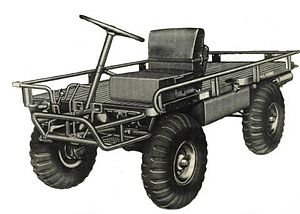
The U.S. Military M274 Truck, Platform, Utility, 1/2 Ton, 4X4 or "Carrier, Light Weapons, Infantry, 1/2 ton, 4x4" aka "Mule," "Military Mule," or "Mechanical Mule" is a 4-wheel drive, gasoline-powered truck/tractor type vehicle that can carry up to a 1/2 ton off-road. It was introduced in 1956 and used until the 1980s. Now it is a military vehicle collectors' item.
The M274 Mule was introduced in 1956 to supplement both the 1/4 ton trucks ("Jeeps") and 3/4 ton trucks (Weapons Carrier Series and M37 series) in airborne and infantry battalions. The M274 evolved from improvements to a vehicle designed at the end of World War Two by Willys-Overland as a medical evacuation litter carrier from areas and terrain that would even be a problem for its famous Jeep to access. Further tests by the US Army at Eglin Field, Florida proved it also useful as carrier for both supplies and men. In 1948 the US Army purchased a small number of these test vehicles with the designation the Jungle Burden Carrier for evaluation in jungle warfare and with airborne forces. There were 11,240 Mules produced between their introduction and 1970, when production ceased. They were used throughout as platforms for various weapons systems and for carrying men, supplies, and weaponry/ammunition during the Vietnam War and in other U.S. military operations until the 1980s. As a completely open and exposed vehicle, they offered absolutely no protection to the driver, yet that was relatively unimportant as they were mainly used as cargo carriers and medium-range infantry support vehicles, rather than tactical vehicles. The driver's seat could be removed and the steering column moved forward and the vehicle driven in reverse to accommodate more cargo. If under fire the steering column could be moved farther forward and down, so the operator could operate the vehicle while crawling behind it. They were phased out from military usage in the 1980s with the introduction of the HMMWV series vehicles. The HMMWV was, however, unable to fulfill the role of the Mule, so the M-Gator, a military variant of the popular John Deere Gator vehicle, was introduced.